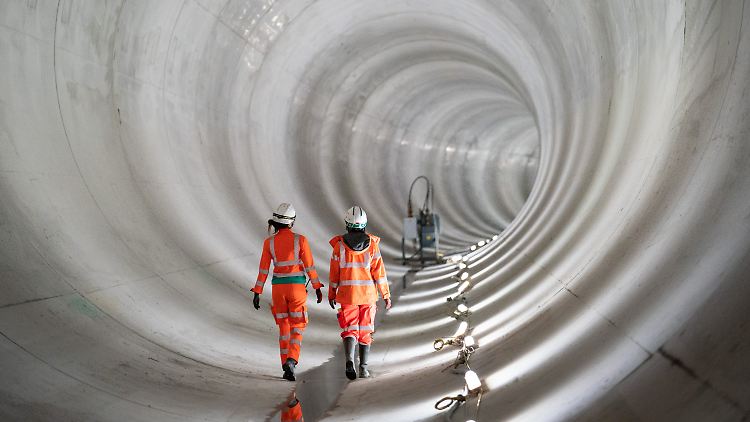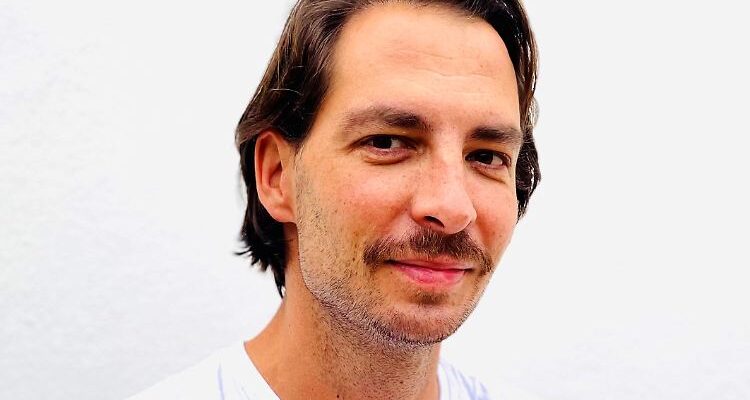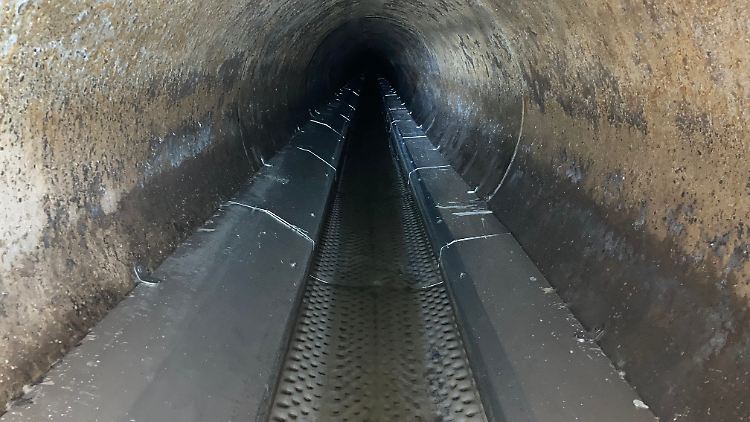Approximately flow through German sewers every year ten billion cubic meters of waste water. Most of it is cleaned in sewage treatment plants and then returned unused to nature. A mistake, says Stephan von Bothmer from the canal construction company TIMELY. This is because waste water contains residual heat that can be used for heating. Accordingly, green warmth slumbers under German feet for up to twelve million people – Invisible and inexpensive: “Among renewables, waste water heat is perhaps even number one,” explains the sewer specialist in ntv’s “Climate Laboratory”. However, many sewer network operators still do not know what treasure they are sitting on.
ntv.de: The big heat transition has just begun in Germany. A lot of people don’t seem too happy with it. As a heating and energy expert, what do you think of the federal government’s plans?
Stephan von Bothmer: Unfortunately, I have to disagree directly. The heat transition has not yet begun, we are about to. Of course, we are concerned that the debate is currently taking on a negative tinge, because if you look at the situation objectively, we have known for 30 years that we have to get out of fossil fuels in the heating sector as well. In fact, almost nothing has happened in the sector in the last three decades. It would be all the more important to push the topic with positive incentives instead of rules and bans.
What positive approaches would that be in your opinion?
That’s easy. We want to convert the area to electricity-based technologies. That’s a great idea, just like the heat pump. Because it uses a little bit of electricity to convert energy that is available for free into heat. But this electricity must become cheaper. Then there would automatically be an incentive to switch. Instead, electricity costs five times more than gas. Then the benefits are harder to see.
But fossil fuels such as gas and oil will definitely become more and more expensive in the medium term due to certificate trading.
That’s right, but no matter how it’s generated, The price of electricity starts directly at 15 or 20 cents per kilowatt hour due to taxes and surcharges alone. This is a competitive disadvantage because power generation is actually very cheap. If all energy sources are treated equally, the problem will solve itself.
Do you see any other viable options? The FDP calls for a technology-open debate that takes into account all heating options and not just heat pumps.
There isn’t that much. Of course you can say that we don’t want to heat everything with electricity, but also with hydrogen. But it is also made from electricity – but unfortunately not very efficiently. In this respect, hydrogen is an option for industry, but not for heating. That’s the reality.
Otherwise there is still bioenergy such as wood pellets. But they have to be transported and stored. As a natural raw material, wood is also associated with uncertainties. You can use solar energy in the form of solar thermal energy, but you need new areas for that. The heat pump is an option that follows the idea of tapping into various energy sources such as soil, air, water and sewage that are available for free and making them usable with a bit of electricity. This is today’s set to work with. If we continue to install oil heaters and gas heaters with a lifetime of 20 to 30 years, we will not be climate-neutral by 2045.
Then the federal government’s bill is going in the right direction.
The plans trigger an important debate, such as the question: How can the heat transition be made socially acceptable? But the proposal misses a few issues, because at the moment the only question seems to be how individual people can pay for the new heating. In large cities, however, there are many large buildings with a large number of apartments in which this case will not occur at all. For this we need other solutions and energy sources such as waste water.
your specialty.
Correct. The exciting thing about wastewater is that it’s where the people are: especially in urban areas with little space to generate energy. The more buildings you connect to this heating network, the further away we move from the ban debate.
Stephan von Bothmer is Managing Director of the Energy division at UHRIG.
(Photo: UHRIG Energie GmbH)
We have already spoken to Berliner Wasserbetriebe about the subject. The bottom line at the time was: Wastewater heat is a great idea, but unfortunately also very expensive, with which you can only provide three to five percent of the heat that is required for heating in Berlin. The situation is even more complicated in other German cities. You, on the other hand, say that wastewater could cover up to 15 percent of the heat demand in the German building sector. How do these differences come about?
Different perspectives are responsible for the information. For us as a plant manufacturer, I can say that we have already implemented 120 projects in Europe, bucking the trend. Of these, 70 or 80 are in Germany, most outside of Berlin (9). We realized 11 in Paris. So we know that the potential is there in different places. Several studies place it at 5 to 15 percent of the heat requirement. But we don’t want to argue about individual percentages at all, but like to make the possibilities better known with a little euphoria.
Very gladly.
In concrete terms, we could supply four to twelve million people with green heat via our wastewater. There are interesting sewers in every city with more than 10,000 inhabitants. And because buildings will be more energy efficient in the future, the heating market will shrink. By how much is open. However, this means that the percentage of wastewater used as a heat source will increase.
Do these four to twelve million refer to Germany or Europe?
On Germany. In this country, 600,000 kilometers of canals are built – we are talking about huge, invisible networks under every city. That is exactly what you want for the energy transition. For example, the London sewer network operator Thames Water puts its Potential to ten terawatt hours (TWh) per year. That is the same amount of heat that the federal government wants to draw from geothermal energy throughout Germany by 2030 – a significant goal for only one city, because London wants to leverage the full potential.
In the study Another comparison is made: Ten TWh would be 40 percent of the energy that Hinkley Point C in Great Britain is supposed to supply one day. So the potential corresponds to half a modern nuclear power plant with an output of 1.6 gigawatts, just in case it ever gets finished. Now the only question that remains is: How do we get the energy in our wastewater?
The physical principle of heat transfer is used: warm waste water flows reliably in the sewer. This warm waste water flows through heat exchangers that are built directly into the infrastructure and that contain cold water. This cold water is heated. If you feed it to a heat pump, you can use it for heating. That works just as well in Berlin as it does in London or New York, because all the channels have a similar structure. This is also not difficult from a technological point of view, our oldest system has been in operation for 15 years. Bringing the right players together is crucial because, as with all innovation, people need to work together who haven’t done it before.
And these players would be?

In London, waste water heat is given a further boost by the new Tideway Tunnel. The 25-kilometer canal is also known as the “Super Sewer”.
(Photo: picture alliance / empics)
Sewer network operators such as Berliner Wasserbetriebe, for example, because they hold the key to the energy source. If they hand that out, a big step has been taken. That’s the case in Berlin, that’s great. Then the appropriate technology has to be installed, and we can deliver that. And it needs a third party to finance and operate the whole thing. This is important because implementation costs money. If you don’t have this money at the moment, the third party steps in, buys the system for you or your building, operates it and sells you the heat per month at a fixed price. All you have to do is pay your bill. The system is paid for after 15 years and can continue to run for decades.
Is that a profitable business?
Yes, among renewable heat sources, wastewater heat is competitive, maybe even number one. I would also like to classify the 15 years again: Of course you can say that you have been tied to one provider for a long time or even gagged. But you also have security for 15 years and you know how much the apartment will cost in winter. This is no longer the case with any gas contract because no one knows how prices will develop. So, wastewater is a very reliable and stable model, with the same dilemma as any other renewable energy source: the fuel is free, but if I want it, I have to make a large initial investment. But the good thing is that third parties are available to take on these investments.
And wastewater can actually produce enough energy to heat entire buildings?
In every city there are hotspots where there is a particularly large amount of wastewater and places where there is less. Because of this, some projects heat entire buildings; in other cases, the waste water can only cover 30 percent, the rest of the energy comes from other sources. This will be the future. That’s why we advocate that cities define their hotspots. Then we can go there, offer a ready solution and make an offer for the surrounding buildings. That’s how we manage maybe more than 20 or 30 projects a year. They’re great, but at that rate, we in Germany would need around 8,000 to 10,000 years to tap the potential. That doesn’t quite fit with the plan to convert 42 million residential units to green heating over the next 20 years.
So you actually need more competitors, right?
We can build a relatively large number of systems ourselves. With our own production, we have increased our capacity by a factor of 35. Nevertheless, we will never be able to serve the world market, that’s clear. Much more important, however, are sewer network operators who are interested in the topic. That’s also a great additional business, if I may put it that way. But for that we have to start a conversation: The sewage industry is on the source, the energy industry can use it, the technologies are there – now we just have to tie it all together.
Talked to Stephan von Bothmer Clara Pepper and Christian Herrmann. The conversation has been shortened and smoothed for better understanding.
What helps against climate change? “Klima-Labor” is the ntv podcast in which Clara Pfeffer and Christian Herrmann examine ideas and claims that sound great but rarely are. Climate neutral companies? lied Climate killer cow? Misleading. artificial meat? Horror 4.0. Reforestation in the south? Exacerbates problems. CO2 prices for consumers? Inevitable. LNG? Expensive.
The climate laboratory – half an hour every Thursday that provides information and cleans up. On ntv and everywhere there are podcasts: RTL+ music, Apple Podcasts, Amazon Music, Google Podcasts, SpotifyRSS feed

